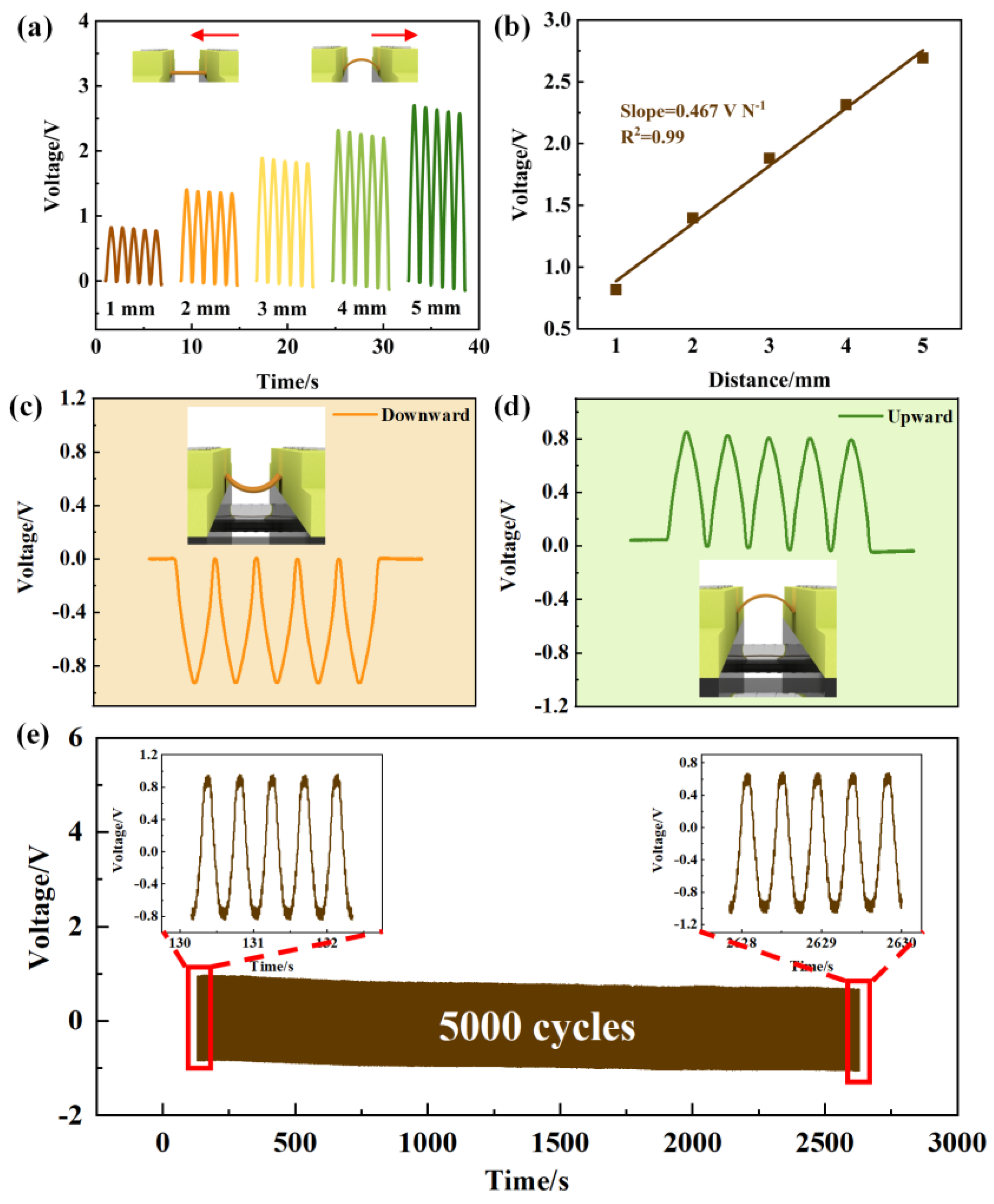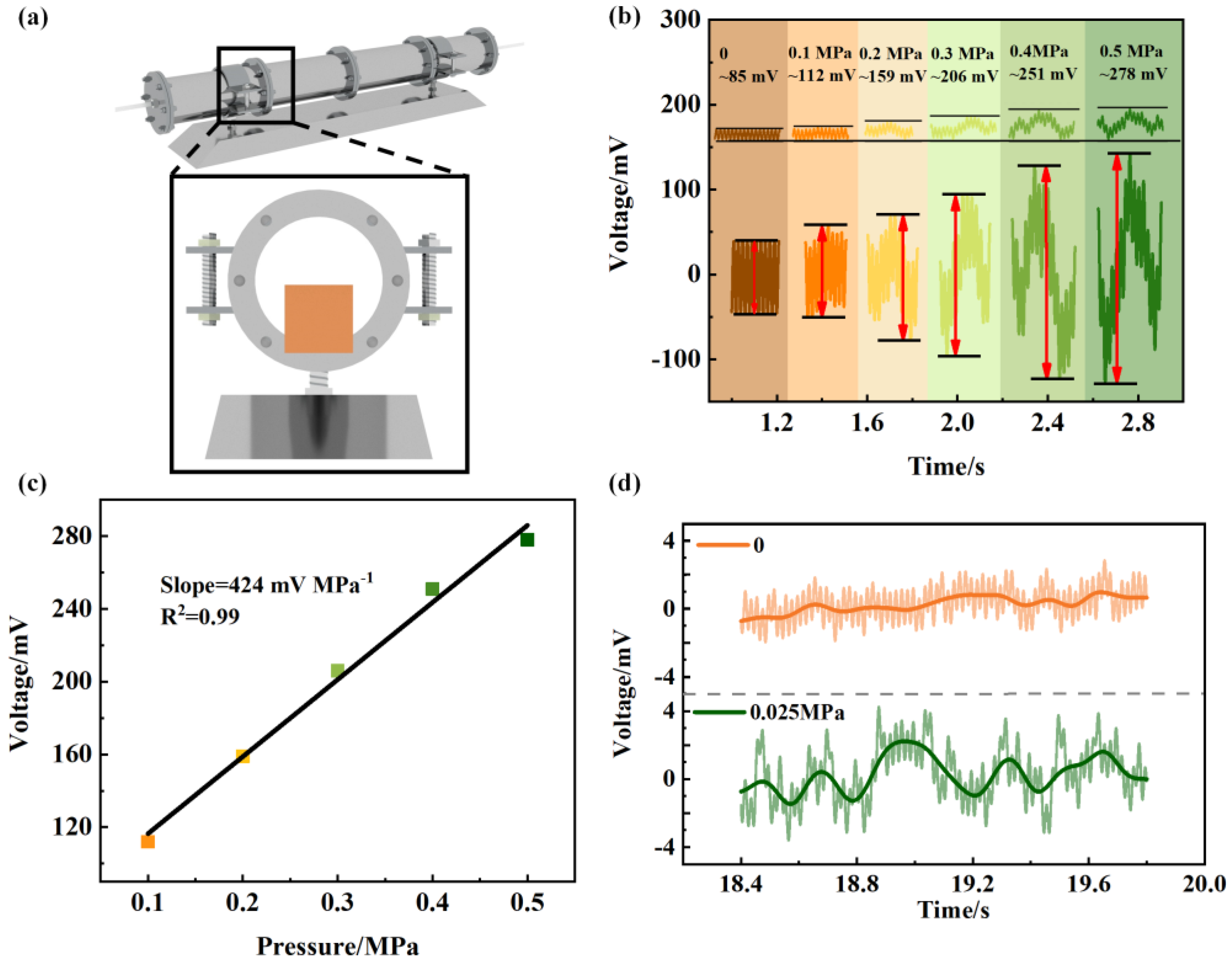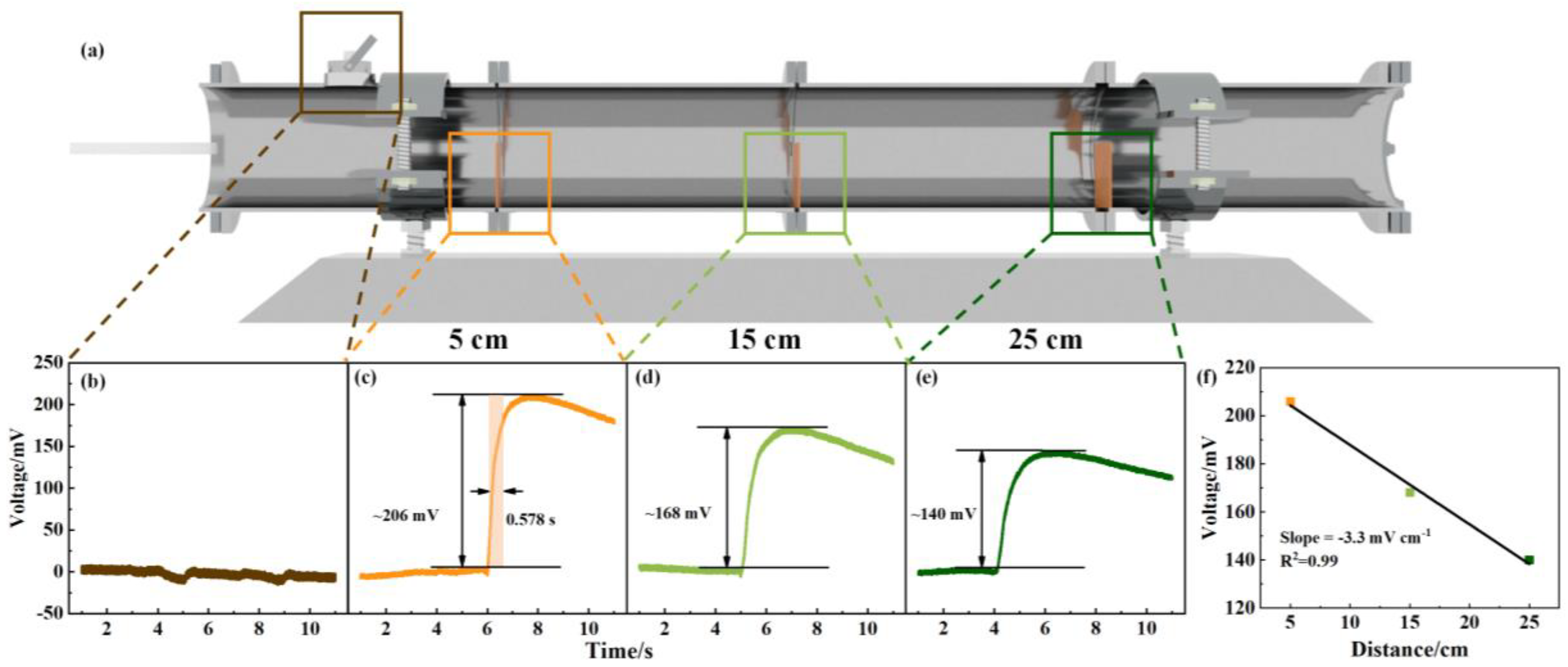Flexible Mica-Based PZT Sensor for Real-Time Monitoring of the Airflow
Abstract
1. Introduction
2. Materials and Methods
2.1. Fabrication of Mica-Based PZT Film
2.2. Characterization of Flexible PZT Films
2.3. Electrical Output Performance Measurements
2.4. Modeling and Meshing of the PZT Film
2.5. Design of Gas Pipeline Model
3. Results and Discussion
4. Conclusions
Supplementary Materials
Author Contributions
Funding
Data Availability Statement
Conflicts of Interest
References
- Davoodi, S.; Mostafapour, A. Modeling Acoustic Emission Signals Caused by Leakage in Pressurized Gas Pipe. J. Nondestr. Eval. 2012, 32, 67–80. [Google Scholar] [CrossRef]
- Song, Y.; Li, S. Gas Leak Detection in Galvanised Steel Pipe with Internal Flow Noise Using Convolutional Neural Network. Process Saf. Environ. Prot. 2021, 146, 736–744. [Google Scholar] [CrossRef]
- Spandonidis, C.; Theodoropoulos, P.; Giannopoulos, F.; Galiatsatos, N.; Petsa, A. Evaluation of Deep Learning Approaches for Oil & Gas Pipeline Leak Detection Using Wireless Sensor Networks. Eng. Appl. Artif. Intell. 2022, 113, 104890. [Google Scholar]
- Zhou, Z.; Zhang, J.; Huang, X.; Guo, X. Experimental Study on Distributed Optical-Fiber Cable for High-Pressure Buried Natural Gas Pipeline Leakage Monitoring. Opt. Fiber Technol. 2019, 53, 102028. [Google Scholar] [CrossRef]
- Parra-Raad, J.A.; Roa-Prada, S. Multi-Objective Optimization of a Magnetic Circuit for Magnetic Flux Leakage-Type Non-destructive Testing. J. Nondestr. Eval. 2016, 35, 14. [Google Scholar] [CrossRef]
- Jiang, T.; Ren, L.; Wang, J.; Jia, Z.; Li, D.; Li, H. Experimental Investigation of Fiber Bragg Grating Hoop Strain Sensor–Based Method for Sudden Leakage Monitoring of Gas Pipeline. Struct. Health Monit. 2020, 20, 3024–3035. [Google Scholar] [CrossRef]
- Ren, L.; Jiang, T.; Jia, Z.; Li, D.; Yuan, C.; Li, H. Pipeline Corrosion and Leakage Monitoring Based on the Distributed Optical Fiber Sensing Technology. Measurement 2018, 122, 57–65. [Google Scholar] [CrossRef]
- Datta, S.; Sarkar, S. A Review on Different Pipeline Fault Detection Methods. J. Loss Prev. Process Ind. 2016, 41, 97–106. [Google Scholar] [CrossRef]
- Long, Y.; Zhang, J.; Huang, S.; Peng, L.; Wang, W.; Wang, S.; Zhao, W. A Novel Crack Quantification Method for Ultra-High-Definition Magnetic Flux Leakage Detection in Pipeline Inspection. IEEE Sens. J. 2022, 22, 16402–16413. [Google Scholar] [CrossRef]
- Ru, G.; Gao, B.; Liu, D.; Ma, Q.; Li, H.; Woo, W.L. Structural Coupled Electromagnetic Sensing of Defects Diagnostic System. IEEE Trans. Ind. Electron. 2023, 70, 951–964. [Google Scholar] [CrossRef]
- Ghasemi, P.; Sharifi, M.J. Optoelectronic Memory Capacitor Based on Manipulation of Ferroelectric Properties. ACS Appl. Mater. Interfaces 2021, 13, 53067–53072. [Google Scholar] [CrossRef] [PubMed]
- Xu, S.; Hansen, B.J.; Wang, Z.L. Piezoelectric-Nanowire-Enabled Power Source for Driving Wireless Microelectronics. Nat. Commun. 2010, 1, 93. [Google Scholar] [CrossRef] [PubMed]
- Dagdeviren, C.; Su, Y.; Joe, P.; Yona, R.; Liu, Y.; Kim, Y.S.; Huang, Y.; Damadoran, A.R.; Xia, J.; Martin, L.W.; et al. Conformable Amplified Lead Zirconate Titanate Sensors with Enhanced Piezoelectric Response for Cutaneous Pressure Monitoring. Nat. Commun. 2014, 5, 4496. [Google Scholar] [CrossRef]
- Yalcinkaya, H.; Ozevin, D. The Design and Calibration of Particular Geometry Piezoelectric Acoustic Emission Transducer for Leak Detection and Localization. Meas. Sci. Technol. 2013, 24, 095103. [Google Scholar] [CrossRef]
- Zhang, M.; Chen, X.; Li, W. Hidden Markov Models for Pipeline Damage Detection Using Piezoelectric Transducers. J. Civ. Struct. Health Monit. 2021, 11, 745–755. [Google Scholar] [CrossRef]
- Feng, Q.; Kong, Q.; Huo, L.; Song, G. Crack Detection and Leakage Monitoring on Reinforced Concrete Pipe. Smart Mater. Struct. 2015, 24, 115020. [Google Scholar] [CrossRef]
- Liu, H.; Zhang, S.; Kathiresan, R.; Kobayashi, T.; Lee, C. Development of Piezoelectric Microcantilever Flow Sensor with Wind-Driven Energy Harvesting Capability. Appl. Phys. Lett. 2012, 100, 223905. [Google Scholar] [CrossRef]
- Ejeian, F.; Azadi, S.; Razmjou, A.; Orooji, Y.; Kottapalli, A.; Ebrahimi Warkiani, M.; Asadnia, M. Design and Applications of MEMS Flow Sensors: A review. Sens. Actuators A 2019, 295, 483–502. [Google Scholar] [CrossRef]
- Hu, J.; Chen, J.; Liu, P.; Fan, S.; Duan, W. Near-Field Electrospinning-Enabled Direct-Write P(VDF-TrFE) Nano/Micro-Fiber-Based Piezoelectric Film for A High-Performance Airflow Sensor. Sens. Actuators A 2022, 336, 113399. [Google Scholar] [CrossRef]
- Corzo, D.; Tostado-Blázquez, G.; Baran, D. Flexible Electronics: Status, Challenges and Opportunities. Front. Electron. 2020, 1, 594003. [Google Scholar] [CrossRef]
- Kong, H.; Sun, W.; Zhou, H. Progress in Flexible Perovskite Solar Cells with Improved Efficiency. J. Semicond. 2021, 42, 101605. [Google Scholar] [CrossRef]
- Wang, X.; Lee, C.; Peng, C.; Chen, P.; Chang, P. A Micrometer Scale and Low Temperature PZT Thick Film MEMS Process Utilizing An Aerosol Deposition Method. Sens. Actuators A 2008, 143, 469–474. [Google Scholar] [CrossRef]
- Qi, Y.; Jafferis, N.T.; Lyons, K., Jr.; Lee, C.M.; Ahmad, H.; McAlpine, M.C. Piezoelectric Ribbons Printed onto Rubber for Flexible Energy Conversion. Nano Lett. 2010, 10, 524–528. [Google Scholar] [CrossRef]
- Pesquera, D.; Khestanova, E.; Ghidini, M.; Zhang, S.; Rooney, A.P.; Maccherozzi, F.; Riego, P.; Farokhipoor, S.; Kim, J.; Moya, X.; et al. Large Magnetoelectric Coupling in Multiferroic Oxide Heterostructures Assembled via Epitaxial Lift-Off. Nat. Commun. 2020, 11, 3190. [Google Scholar] [CrossRef]
- Park, K.I.; Son, J.H.; Hwang, G.T.; Jeong, C.K.; Ryu, J.; Koo, M.; Choi, I.; Lee, S.H.; Byun, M.; Wang, Z.L.; et al. Highly-Efficient, Flexible Piezoelectric PZT Thin Film Nanogenerator on Plastic Substrates. Adv. Mater. 2014, 26, 2514–2520. [Google Scholar] [CrossRef]
- Zhu, C.; Guo, D.L.; Ye, D.; Jiang, S.; Huang, Y.A. Flexible PZT-Integrated, Bilateral Sensors via Transfer-Free Laser Lift-Off for Multimodal Measurements. ACS Appl. Mater. Interfaces 2020, 12, 37354–37362. [Google Scholar] [CrossRef]
- Zhong, G.; An, F.; Qu, K.; Dong, Y.; Yang, Z.; Dai, L.; Xie, S.; Huang, R.; Luo, Z.; Li, J. Highly Flexible Freestanding BaTiO3-CoFe2O4 Heteroepitaxial Nanostructure Self-Assembled with Room-Temperature Multiferroicity. Small 2022, 18, 2104213. [Google Scholar] [CrossRef]
- Park, D.Y.; Joe, D.J.; Kim, D.H.; Park, H.; Han, J.H.; Jeong, C.K.; Park, H.; Park, J.G.; Joung, B.; Lee, K.J. Self-Powered Real-Time Arterial Pulse Monitoring Using Ultrathin Epidermal Piezoelectric Sensors. Adv. Mater. 2017, 29, 1702308. [Google Scholar] [CrossRef]
- Lee, H.S.; Chung, J.; Hwang, G.T.; Jeong, C.K.; Jung, Y.; Kwak, J.H.; Kang, H.; Byun, M.; Kim, W.D.; Hur, S.; et al. Flexible Inorganic Piezoelectric Acoustic Nanosensors for Biomimetic Artificial Hair Cells. Adv. Funct. Mater. 2014, 24, 6914–6921. [Google Scholar] [CrossRef]
- Gabrielsson, E.O.; Jung, Y.H.; Han, J.H.; Joe, D.J.; Simon, D.T.; Lee, K.J.; Berggren, M. Autonomous Microcapillary Drug Delivery System Self-Powered by a Flexible Energy Harvester. Adv. Mater. Technol. 2021, 6, 2100526. [Google Scholar] [CrossRef]
- Zhang, B.; Yun, C.; MacManus-Driscoll, J.L. High Yield Transfer of Clean Large-Area Epitaxial Oxide Thin Films. Nano Micro Lett. 2021, 13, 39. [Google Scholar] [CrossRef] [PubMed]
- Li, D.; Adamo, C.; Wang, B.Y.; Yoon, H.; Chen, Z.; Hong, S.S.; Lu, D.; Cui, Y.; Hikita, Y.; Hwang, H.Y. Stabilization of Sr3Al2O6 Growth Templates for Ex Situ Synthesis of Freestanding Crystalline Oxide Membranes. Nano Lett. 2021, 21, 4454–4460. [Google Scholar] [CrossRef] [PubMed]
- Jin, C.; Zhu, Y.; Li, X.; An, F.; Han, W.; Liu, Q.; Hu, S.; Ji, Y.; Xu, Z.; Hu, S.; et al. Super-Flexible Freestanding BiMnO3 Membranes with Stable Ferroelectricity and Ferromagnetism. Adv. Sci. 2021, 8, 2102178. [Google Scholar] [CrossRef] [PubMed]
- Wang, D.; Yuan, G.; Hao, G.; Wang, Y. All-Inorganic Flexible Piezoelectric Energy Harvester Enabled by Two-Dimensional Mica. Nano Energy 2018, 43, 351–358. [Google Scholar] [CrossRef]
- Zou, D.; Liu, S.; Zhang, C.; Hong, Y.; Zhang, G.; Yang, Z. Flexible and Translucent PZT Films Enhanced by the Compositionally Graded Heterostructure for Human Body Monitoring. Nano Energy 2021, 85, 105984. [Google Scholar] [CrossRef]
- Er, X.; Wang, H.; Shao, P.; Ma, Q.; Chu, Y.; Zhan, Q. The Microstructure and Ferroelectric Properties of PbZr0.52Ti0.48O3 Films on Mica Substrates. Ceram. Int. 2021, 47, 9252–9257. [Google Scholar] [CrossRef]
- Lv, P.; Qian, J.; Yang, C.; Liu, T.; Wang, Y.; Wang, D.; Huang, S.; Cheng, X.; Cheng, Z. Flexible All-Inorganic Sm-Doped PMN-PT Film with Ultrahigh Piezoelectric Coefficient for Mechanical Energy Harvesting, Motion Sensing, and Human-Machine Interaction. Nano Energy 2022, 97, 107182. [Google Scholar] [CrossRef]
- Nguyen, M.D.; Houwman, E.P.; Dekkers, M.; Rijnders, G. Strongly Enhanced Piezoelectric Response in Lead Zirconate Titanate Films with Vertically Aligned Columnar Grains. ACS Appl. Mater. Interfaces 2017, 9, 9849–9861. [Google Scholar] [CrossRef] [PubMed]
- Yen, M.; Bitla, Y.; Chu, Y. van der Waals Heteroepitaxy on Muscovite. Mater. Chem. Phys. 2019, 234, 185–195. [Google Scholar] [CrossRef]
- Qi, H.; Yang, J.; Chen, H.; Wang, C.; Tao, J.; Dai, W.; Wu, T.; Li, J. Influence of Substrate Thickness on the Electrical Properties of Flexible PbZr0.52Ti0.48O3 Thin Films Grown on Mica. J. Electron. Mater. 2020, 49, 5449–5454. [Google Scholar] [CrossRef]
- Zhu, J.; Ren, L.; Ho, S.; Jia, Z.; Song, G. Gas Pipeline Leakage Detection Based on PZT Sensors. Smart Mater. Struct. 2017, 26, 025022. [Google Scholar] [CrossRef]
- Oke, A.; Mahgerefteh, H.; Economou, I.; Rykov, Y. A Transient Outflow Model for Pipeline Puncture. Chem. Eng. Sci. 2003, 58, 4591–4604. [Google Scholar] [CrossRef]
- Nie, Y.; Deng, P.; Zhao, Y.; Wang, P.; Xing, L.; Zhang, Y.; Xue, X. The Conversion of PN-Junction Influencing the Piezoelectric Output of A CuO/ZnO Nanoarray Nanogenerator and Its Application as A Room-Temperature Self-Powered Active H2S Sensor. Nanotechnology 2014, 25, 265501. [Google Scholar] [CrossRef]
- Sardana, S.; Kaur, H.; Arora, B.; Aswal, D.K.; Mahajan, A. Self-Powered Monitoring of Ammonia Using an MXene/TiO2/Cellulose Nanofiber Heterojunction-Based Sensor Driven by an Electrospun Triboelectric Nanogenerator. ACS Sens. 2022, 7, 312–321. [Google Scholar] [CrossRef]
- Chang, J.; Zhu, C.; Wang, Z.; Wang, Y.; Li, C.; Hu, Q.; Xu, R.; Du, T.; Xu, M.; Feng, L. A Full-Set and Self-Powered Ammonia Leakage Monitor System Based on CNTs-PPy and Triboelectric Nanogenerator for Zero-Carbon Vessels. Nano Energy 2022, 98, 107271. [Google Scholar] [CrossRef]
- Fu, Y.; Nie, Y.; Zhao, Y.; Wang, P.; Xing, L.; Zhang, Y.; Xue, X. Detecting Liquefied Petroleum Gas (LPG) at Room Temperature Using ZnSnO3/ZnO Nanowire Piezo-Nanogenerator as Self-Powered Gas Sensor. ACS Appl. Mater. Interfaces 2015, 7, 10482–10490. [Google Scholar] [CrossRef]






Disclaimer/Publisher’s Note: The statements, opinions and data contained in all publications are solely those of the individual author(s) and contributor(s) and not of MDPI and/or the editor(s). MDPI and/or the editor(s) disclaim responsibility for any injury to people or property resulting from any ideas, methods, instructions or products referred to in the content. |
© 2023 by the authors. Licensee MDPI, Basel, Switzerland. This article is an open access article distributed under the terms and conditions of the Creative Commons Attribution (CC BY) license (https://creativecommons.org/licenses/by/4.0/).
Share and Cite
Jia, M.; Xu, Q.; Zhai, D.; Yan, M.; Jiang, S.; Tang, M.; Zhang, D.; Zhu, W.; Zhang, Y. Flexible Mica-Based PZT Sensor for Real-Time Monitoring of the Airflow. Crystals 2023, 13, 855. https://doi.org/10.3390/cryst13060855
Jia M, Xu Q, Zhai D, Yan M, Jiang S, Tang M, Zhang D, Zhu W, Zhang Y. Flexible Mica-Based PZT Sensor for Real-Time Monitoring of the Airflow. Crystals. 2023; 13(6):855. https://doi.org/10.3390/cryst13060855
Chicago/Turabian StyleJia, Miao, Qianqian Xu, Di Zhai, Mingyang Yan, Shumiao Jiang, Minxuan Tang, Dou Zhang, Wei Zhu, and Yan Zhang. 2023. "Flexible Mica-Based PZT Sensor for Real-Time Monitoring of the Airflow" Crystals 13, no. 6: 855. https://doi.org/10.3390/cryst13060855
APA StyleJia, M., Xu, Q., Zhai, D., Yan, M., Jiang, S., Tang, M., Zhang, D., Zhu, W., & Zhang, Y. (2023). Flexible Mica-Based PZT Sensor for Real-Time Monitoring of the Airflow. Crystals, 13(6), 855. https://doi.org/10.3390/cryst13060855






